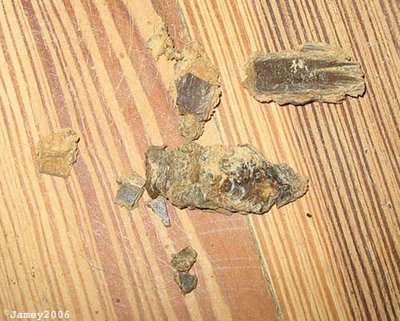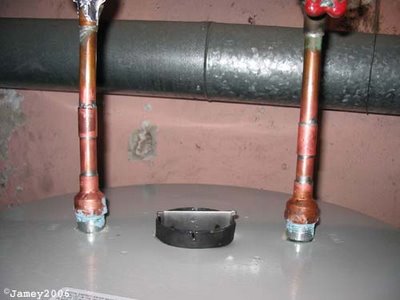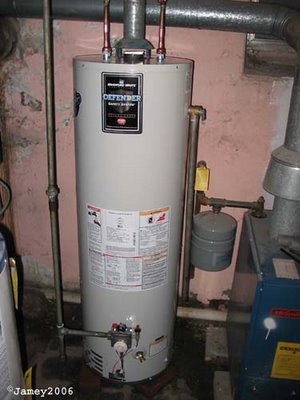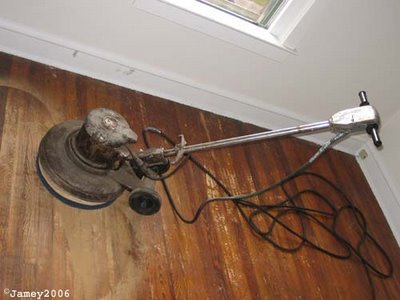Philosophy
When you are doing a job...especially if it's a re-doing...
It doesn't matter who made the mistake.
If the mistake is there when you are finished...
It's your mistake, you own it.
When you are doing a job...especially if it's a re-doing...
I just finished up with the 100 grit sanding using my floor machine.



This is probably the worst spot on the whole floor. I'm chipping out some of the splitting wood and sanding the rest down smooth.


The 80 grit is the highest I got at Home Depot for my big sander...Was the highest they had at the one I was at. I checked on my fotolog and saw that I went up to 100 grit with the machine last time. I found 100 grit screen at the Home Depot I went to last night (a different one) so I'll be doing one more sanding with the big machine this weekend (well, 2 more...I'll do 2 complete passes with it).
Unfortunately I did some reading on the Minwax message boards...And I need to go up to 180 grit (do 120 and 150 grit first) before I start to stain and poly. It also said I have to use my drywall pole sander with sanding screens for the higher grits and not the machine to minimize swirls on the floor. I'm going to do it this time because when I did my living room floor 2 years ago I got a lot of swirls in the finished product...The stain and poly really brought them out. Most people say they don't notice them...But when I look at the floor they are pretty much all I see.
The palm sander is doing a great job on the edges for me and also on any low spots in the room that still have remnants of the old finish on them still.
I know it's taking me a long time to do this floor...And I have a long way to go. But I want to do this one as best I can, the perfectionist in me wants to see just how good I can do it...How good the final result can be. If it takes me too too long...I may just put carpet in the other bedrooms, it's much faster. And that way at least a potential buyer will see just how good they can look. Who knows though, I do have a lot more of the sanding stuff for the machine....So maybe in a month when I move stuff back into this room I'll go ahead and start on the next one.
Well...I tried doubling up the blue pads...Didn't work, it didn't spin and they pulled right off the bottom of the machine.
With the water heater situation resolved I'm back to work re-finishing the floor.



Ok...So to review...
Once I put the pipe dope on the threads on top of the heater I put the connectors I made on. I made sure I cranked them down good and tight because once I made the solder connections there would be no more turning of the connectors.

One thing I thought was kinda weird...Was that I had to prop the new water heater up on bricks so it wouldn't be sitting on the basement floor. The old ones both have 'feet' on the bottom.
So here are the water lines all connected up. So now you can see that if I had done it all in-place, not only would the bottom joint have been really close to the heater and could have caused problems, but the next joint up would have had to have been soldered upside-down...Not impossible, but why make things harder when you don't have to?

So once the water lines were all together, I re-connected the gas line...Turned everything back on...And fired it up.
 Half an hour after connecting it and turning it on I was enjoying a nice hot shower :)
Half an hour after connecting it and turning it on I was enjoying a nice hot shower :)
Overall, not a bad little project. Nothing was very hard about it...And I got to play with my torch.
So while I was busying myself sanding the bedroom floor...My water heater decided to spring a leak. It wasn't raining out so I knew something was wrong when I went down and the basement floor was all wet.





Since I can only add 5 pictures at a time, this is all you'll get for now. Next update will have the rest of the insallation process.
Starting with the well used piece of 20 grit sandpaper...

And...all together now...
Overall it's been working pretty well. After some initial tweaking of the bolt that holds everything together (had to drill a hole in it and put a cotter pin through it because the machines rotation kept loosening the bolt, and then I had to grind the end of the bolt down a little because it started touching the floor), the main problem I am running into is the 'varnish' I'm sanding off turning into lumps of goo making the sandpaper stick to the floor...it stops it from spinning and sometimes even rips it off the bottom of the machine.
Here are a couple more pix I couldn't get to post the other day.


Yup...been a while since I've posted here.

That's the pad holder on the bottom of the machine.
Here's the new switch I put on. The old one worked when you held the handles in...that one was obsolete and irreplaceable so I ended up just getting a toggle switch I mounted by drilling a hole through the housing and bolting it on.

So now I'm off to sand.
Did I mention I only paid $20 for it? :o)